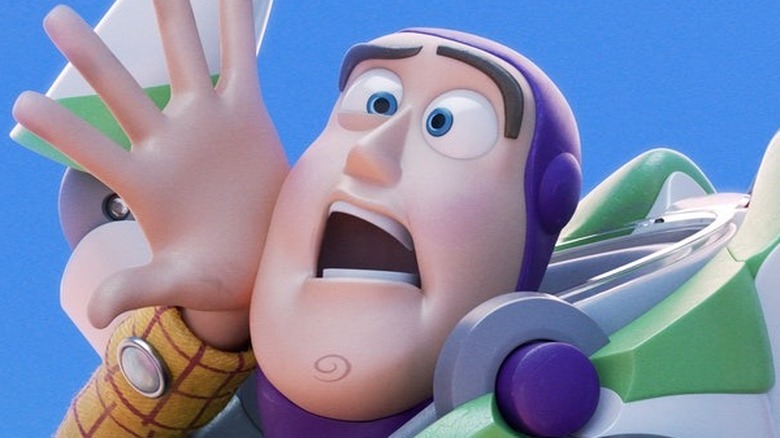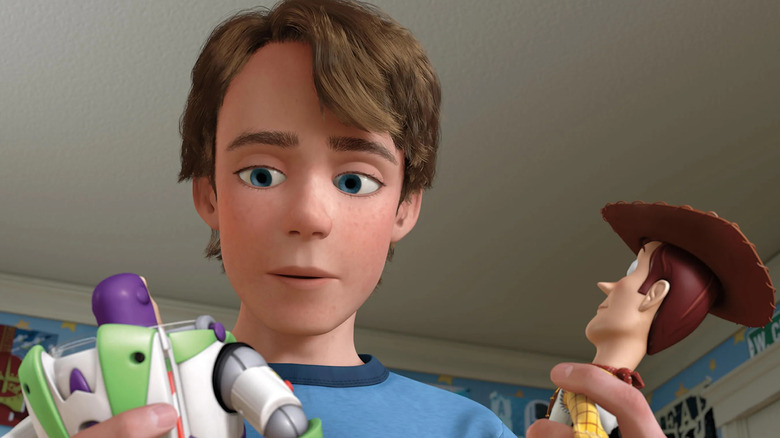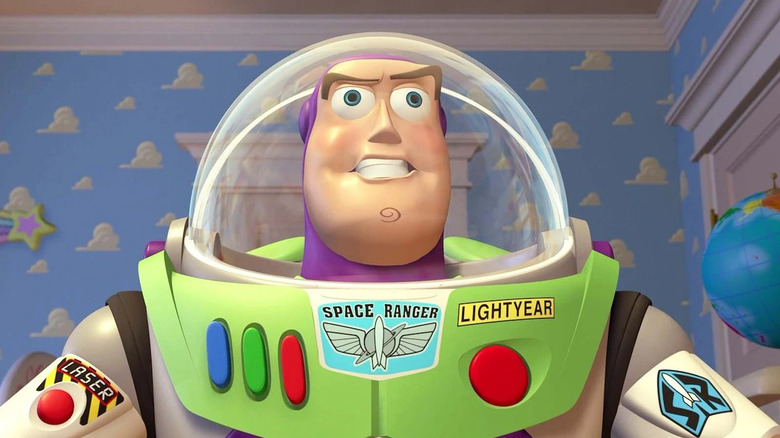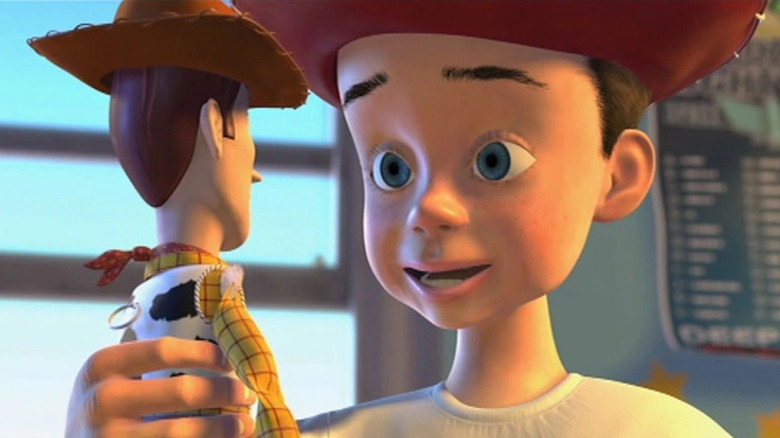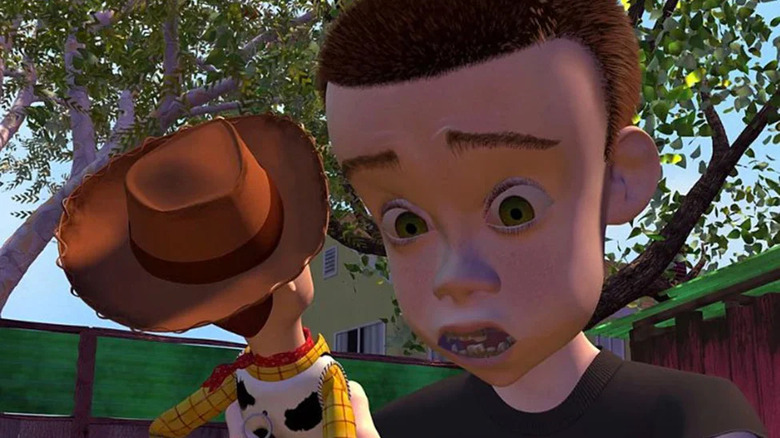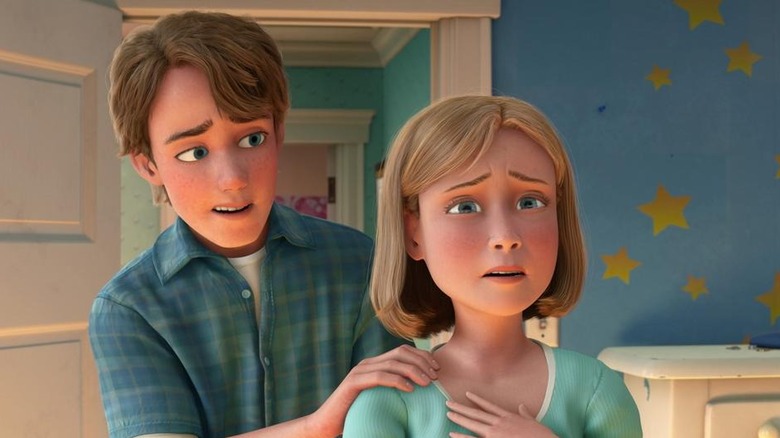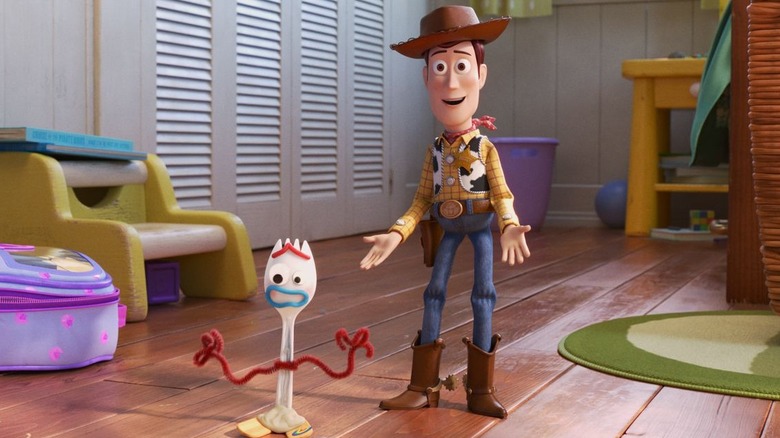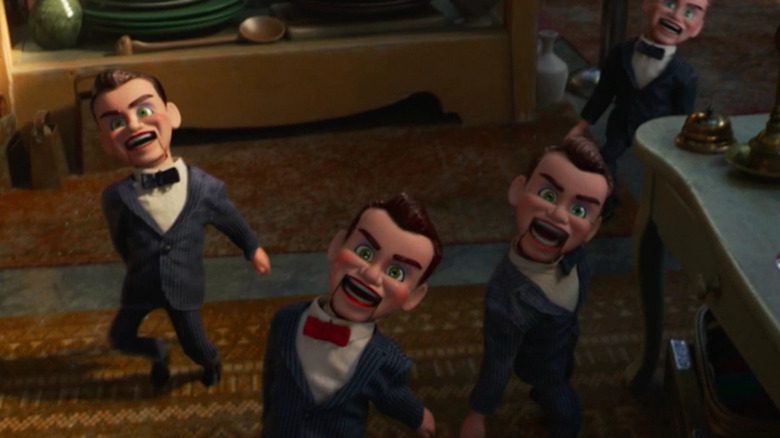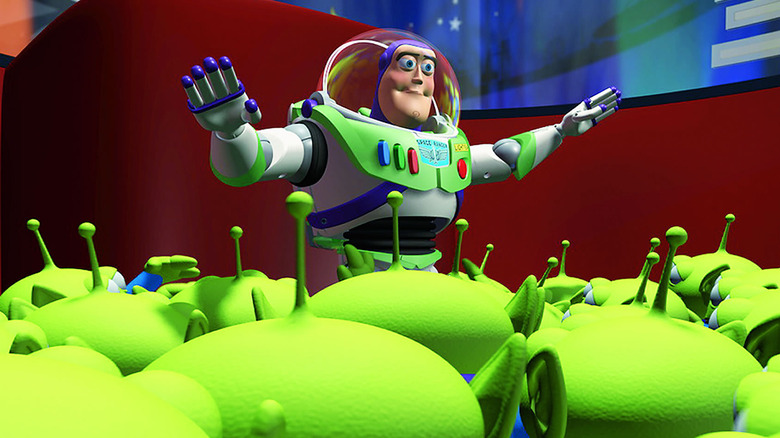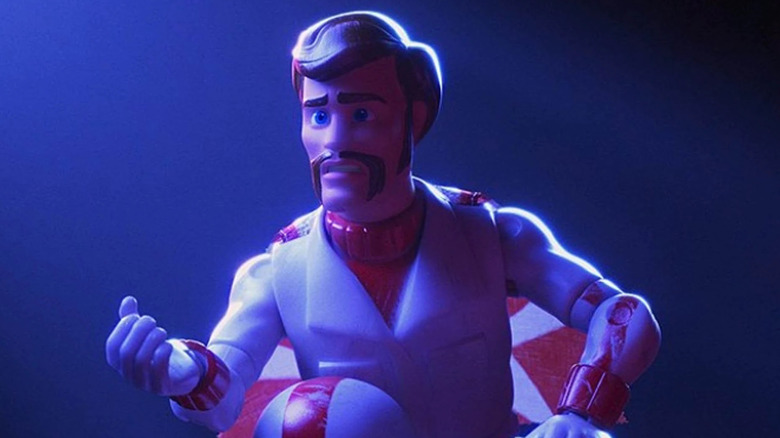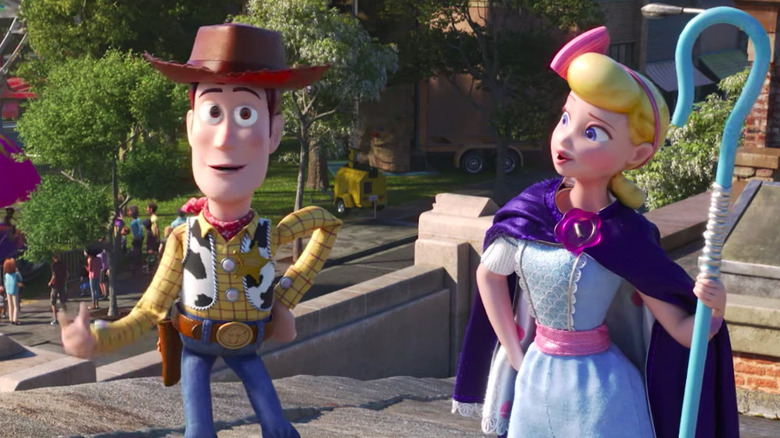The Toy Story Franchise's Biggest Unanswered Questions
Pixar Animation Studios' most iconic franchise is still its first. The "Toy Story" film series remains among the most beloved animated movie properties of all time, with four theatrically released films, a line of TV specials and merchandising, and the animated spinoff movie "Lightyear" starring Chris Evans in the titular role. The franchise is as popular as ever, but there are still some lingering questions about the story and the characters that remain unanswered years after the release of "Toy Story 4." From the final fates of our beloved toy heroes to what is really behind the nature of sentient toys, there are a bunch of major unaddressed plot holes and loose ends that still have fans grasping for more details.
With that in mind, here are all the biggest unanswered questions from the "Toy Story" movies as the franchise continues forward, to infinity and beyond. Major "Toy Story" spoilers ahead.
Whatever happened to Andy?
The human character that looms largest over the entire "Toy Story" franchise is Andy Davis, the owner of the main toy cast until the end of "Toy Story 3." Introduced as a child in the first film, Andy is revealed to be 17 at the start of "Toy Story 3," preparing to leave home to attend college. Andy gives his toys to his next door neighbor Bonnie, feeling she will appreciate them more than he will, before presumably leaving his beloved Woody and Buzz behind forever.
Andy is only seen in flashback sequences in "Toy Story 4," though Woody and the others refer to him constantly in the movie and the spinoffs "Toy Story of Terror!" and "Toy Story That Time Forgot." It is never revealed where Andy goes to college and what he intends to major in as he progresses into adulthood. For a character that figures so prominently in the "Toy Story" mythos, Andy's absence following "Toy Story 3" remains deeply felt, and his life after parting ways with the toys remains a mystery.
How did Buzz know how to act like a toy?
Upon his introduction in the first "Toy Story" film, Buzz Lightyear is convinced he's a real-life human exploring a strange new world on behalf of Star Command. This outlook informs Buzz's character arc throughout the original film, culminating in a nervous breakdown after learning that he is in fact an action figure. Despite this perspective, Buzz still instinctively snaps into an inert state whenever around humans, behaving like the other toys who are aware of their true nature.
Buzz's reflexive action to freeze when in the immediate vicinity of humans implies that there may be a natural instinct among toys to maintain the secret of their sentience. "Toy Story" co-writer and animator Pete Docter addressed the plot hole years later, noting that Buzz's actions around humans were something he and the creative team discussed. However, Doctor shared that no one cared enough about the discrepancy to warrant it being addressed in the film itself.
How did Andy get Woody?
When introduced in the original "Toy Story," Woody appeared to be little more than a standard cowboy doll, complete with a voice box activated by a drawstring. The background of Andy's favorite toy is explored in 1999's "Toy Story 2," which revealed that he is actually a highly rare collectible based on a 1950s television series called "Woody's Roundup." This surprising turn of events opened up questions about how Andy was able to obtain such a rare and valuable toy in the first place, seemingly unaware of — or uninterested in — Woody's collectible worth.
In "Toy Story 2," Stinky Pete claims that Woody is a hand-me-down toy that eventually came into Andy's possession, though this is never fully elaborated on. This also doesn't explain why Woody is unable to recall his own history before he was adopted by Andy — he's surprised upon learning his backstory from a taped episode of his 1950s namesake series. Throughout the movies, toys are shown to retain their memories upon switching owners, making Woody's unusual bout of amnesia all the more perplexing and heightening the mystery.
What happened to Sid after his confrontation with Woody?
Andy's antisocial neighbor Sid Phillips is the "Toy Story" franchise's first true antagonist, a boy who destroys any toy that he can get his hands on, whether they belong to him or not. He carries out bizarre experiments on the toys in his possession, dismantling them and customizing them with garish new attachments. Sid's disturbing behavior finally catches up to him at the end of the original movie as Woody reveals his sentience to warn the boy about messing with toys.
Woody's shocking confrontation with Sid — accompanied by all the toys that he abused over the years emerging from hiding — visibly traumatizes the boy. However, it's unclear how Sid reacts to the revelation that toys are alive. Did he dismiss it as a vivid hallucination? Did he need years of therapy? Sid is last seen in a "Toy Story 3" cameo appearance: He works as a garbage man, still wearing the same skull t-shirt he wore in the original film. He seems to be a functioning member of society, so we assume there was no lasting psychological damage.
What happened to Andy's dad?
In the first three "Toy Story" movies, Woody and his friends are owned and cared for by the Davis family: Andy, his younger sister Molly, and their mother. One family member conspicuously absent throughout the film series is Andy's unnamed father, who is never directly referred to in the movies. It is unclear if Andy's father passed away before the events of the first film, if his parents divorced, or if they were never actually married at all. No details are given about the Davis family's background.
One popular fan theory that has circulated online for years states that Andy's father died of complications from polio, passing the Woody doll (his prized childhood possession) down to his son. Late Pixar writer Joe Ranft supposedly told this tragic tale to Mike Mozart (a toy consultant on the first film) before the former died in 2005. However, the story was debunked by "Toy Story" co-writer and longtime Pixar filmmaker Andrew Stanton in a since-deleted tweet. This leaves what became of Andy's father an open mystery that the movies themselves have never addressed.
What exactly are the parameters for a toy to become sentient?
The first new toy introduced in "Toy Story 4" is Forky, a makeshift toy constructed by Bonnie as part of an arts and crafts project when she begins kindergarten. Bonnie plays with Forky at school and the toy suddenly gains sentience on the ride back home, to his sheer horror — he's left grappling with his newfound existence. Forky's existential nightmare raises some serious questions about what exactly qualifies as a toy in the "Toy Story" universe. How much playtime is needed for something to become sentient?
Prior to Forky's introduction, it was commonly accepted that any conventional toy would have a degree of sentience, from action figures to R.C. cars. "Toy Story 4" posits that any crudely constructed inanimate object that receives enough love and attention could qualify as a toy and gain sentience. This also comes with a level of self-awareness, as Forky initially believes himself to be more like a piece of sentient trash than a true toy like his counterparts.
Why can't the Bensons talk?
The scariest toys seen in the "Toy Story" franchise to date are the Bensons, a small army of ventriloquist dummies that debuted in "Toy Story 4." Unlike other toys seen in the franchise, however, the Bensons are unable to speak, silently carrying out their orders with little more than grunts. This stands in contrast to the previously introduced toys, many of whom can speak without the use of voice boxes, like Bo Peep or the plastic army men.
From a filmmaking standpoint, this makes the Bensons creepier as they are able to conceal their approach through their silence. The in-universe rationale for the Bensons' inability to speak is never addressed, though, but it could stem from the dummies working for a talking doll. Their boss Gabby Gabby is an intensely jealous character. Neglected by her owner, she could have ordered the Bensons to stay quiet to be the only toy in her antique store home that can be heard.
Do all toys think they are real at first?
The first "Toy Story" centered on Buzz gradually coming to the realization that he is a sentient toy and not a real-life space ranger as he initially believed. "Toy Story 2" doubles down on this position by briefly featuring an entire toy section filled with Buzz Lightyear and Emperor Zurg action figures who think they're real as they awaken from their packaging. This suggests that every single toy has difficulty grasping their true nature and goes through a similar identity crisis when they first become sentient.
"Toy Story 4" provides an interesting update on the nature of the toys' existence and sentience with the introduction of Forky. With Forky being a handmade toy rather than a stylishly designed action figure like Buzz, he is more puzzled by what he truly is as he gains sentience. Forky's birth and the experiences of the Buzz action figures imply that every toy struggles with their identity at first but quickly settles into their roles.
What traumatized Duke Caboom?
One of the major new characters introduced in "Toy Story 4" is the action figure Duke Caboom, voiced by Keanu Reeves. Over the course of the movie, Duke is revealed to be designed as a 1970s daredevil motorcycle rider from Canada, living as something of an outcast toy for decades. Despite Duke's boisterous persona, he has a surprisingly tragic past that stops him in his tracks whenever he attempts to carry out daring stunts. Duke reveals that he was abandoned by his original owner, who was disappointed that he couldn't carry out the epic stunts from his commercials.
Duke's backstory was created by the filmmakers in response to Reeves' genuine curiosity about his character, giving the toy more depth than originally intended. His trauma extends beyond being reminded of his original owner, however — he freezes up when overcome by anxiety several times during the movie. Though this presumably stems from Duke's lingering abandonment issues, there are hints that Duke has endured other haunting experiences in the years since. We would love to see a Duke Caboom spinoff at some point.
What will become of Woody and Bo Peep?
Woody has always insisted that a toy's primary function is to be there to entertain and comfort their human owners, and this is a major part of who he is as a character. This is called directly into question in "Toy Story 4," with Woody's new owner Bonnie completely ignoring him in favor of her other toys, leaving Woody feeling neglected. This leads Woody to leave Bonnie behind, leaping into an uncertain future with Bo Peep, Duke, Duck, Bunny, and Giggle, all without owners.
Woody and his friends vow to help lost toys find new human owners, but the ensemble is never seen or heard from again. With Buzz and the rest of the gang remaining with Bonnie, it is unknown if they will ever see their old friend again and if Woody is successful in his new life's work. Pixar has confirmed that it is open to the possibility of producing a fifth "Toy Story" film, which would potentially reveal what Woody and his friends have been up to since.
